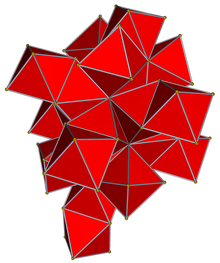24-cell
| 24-cell | |
|---|---|
 Schlegel diagram (vertices and edges) | |
| Type | Convex regular 4-polytope |
| Schläfli symbol | {3,4,3} r{3,3,4} = {31,1,1} = |
| Coxeter diagram | |
| Cells | 24 {3,4} |
| Faces | 96 {3} |
| Edges | 96 |
| Vertices | 24 |
| Vertex figure | Cube |
| Petrie polygon | dodecagon |
| Coxeter group | F4, [3,4,3], order 1152 B4, [4,3,3], order 384 D4, [31,1,1], order 192 |
| Dual | Self-dual |
| Properties | convex, isogonal, isotoxal, isohedral |
| Uniform index | 22 |
In geometry, the 24-cell is the convex regular 4-polytope[1] (four-dimensional analogue of a Platonic solid) with Schläfli symbol {3,4,3}. It is also called C24, or the icositetrachoron,[2] octaplex (short for "octahedral complex"), icosatetrahedroid,[3] octacube, hyper-diamond or polyoctahedron, being constructed of octahedral cells.
The boundary of the 24-cell is composed of 24 octahedral cells with six meeting at each vertex, and three at each edge. Together they have 96 triangular faces, 96 edges, and 24 vertices. The vertex figure is a cube. The 24-cell is self-dual.[a] It and the tesseract are the only convex regular 4-polytopes in which the edge length equals the radius.[b]
The 24-cell does not have a regular analogue in 3 dimensions. It is the only one of the six convex regular 4-polytopes which is not the four-dimensional analogue of one of the five regular Platonic solids. However, it can be seen as the analogue of a pair of irregular solids: the cuboctahedron and its dual the rhombic dodecahedron.
Translated copies of the 24-cell can tile four-dimensional space face-to-face, forming the 24-cell honeycomb. As a polytope that can tile by translation, the 24-cell is an example of a parallelotope, the simplest one that is not also a zonotope.
Geometry[]
The 24-cell incorporates the geometries of every convex regular polytope in the first four dimensions, except the 5-cell, those with a 5 in their Schlӓfli symbol,[c] and the polygons {7} and above. It is especially useful to explore the 24-cell, because one can see the geometric relationships among all of these regular polytopes in a single 24-cell or its honeycomb.
The 24-cell is the fourth in the sequence of 6 convex regular 4-polytopes (in order of size and complexity).[d] It can be deconstructed into 3 overlapping instances of its predecessor the tesseract (8-cell), as the 8-cell can be deconstructed into 2 overlapping instances of its predecessor the 16-cell. WIKI


